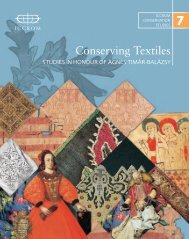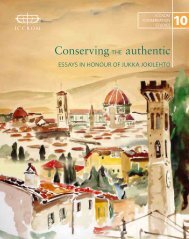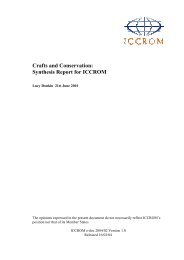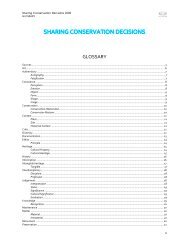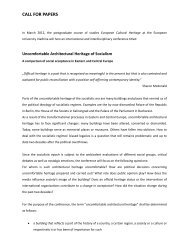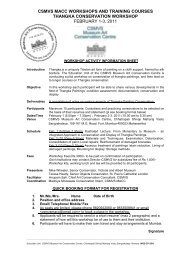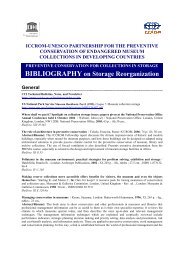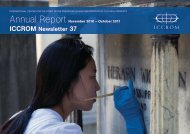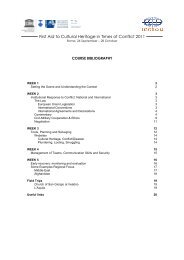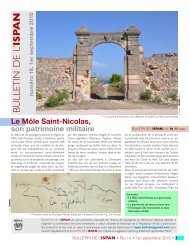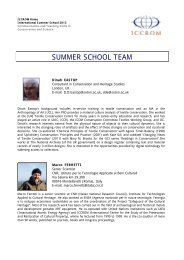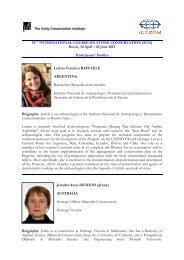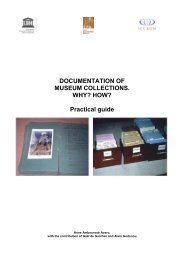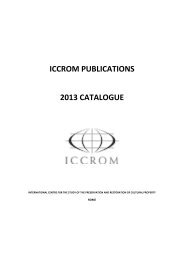part 1 - Iccrom
part 1 - Iccrom
part 1 - Iccrom
You also want an ePaper? Increase the reach of your titles
YUMPU automatically turns print PDFs into web optimized ePapers that Google loves.
MEASURING HERITAGE CONSERVATION PERFORMANCE<br />
6th International Seminar on Urban Conservation<br />
Assomo Eloundou (UNESCO WHC), the issue of<br />
development was still regarded as a threat (ibid.).<br />
These developmental pressures are jeopardizing<br />
the OUV of the Stone Town. As stated above, the<br />
main question of this research is: how can the Stone<br />
Town develop sustainably, without damaging its<br />
Outstanding Universal Value? The content of this<br />
question has been divided in three sub-questions: 1)<br />
what is the current level of authenticity and integrity<br />
of the OUV of the Stone Town? 2) who are the<br />
stakeholders involved in the managing of the OUV<br />
of the Stone Town and what are their roles? and<br />
finally, 3) what are the development-related threats<br />
and respective causes found affecting the OUV of<br />
the Stone Town? Since this article presents the initial<br />
results of the research, it will focus mainly on the<br />
first sub-question.<br />
2. Background<br />
The WHC defines OUV as the “cultural significance<br />
which is so exceptional as to transcend national<br />
boundaries and to be of common importance for<br />
present and future generations of all humanity”<br />
(UNESCO, 2008, p. 14). The WHC considers a property<br />
as having OUV whenever a property meets one<br />
or more of the ten selection criteria. 4 The carriers of<br />
the OUV are coined as ‘attributes’. These attributes<br />
“are a direct tangible expression of the outstanding<br />
universal value of the property” (ICCROM et<br />
al., 2010). In addition the Guidance on the preparation<br />
of Retrospective Statements of Outstanding<br />
Universal Value for World Heritage Properties,<br />
states that attributes “include the physical elements<br />
of the property and may include the relationships<br />
between physical elements, essence, meaning, and<br />
at times related processes, that need to be protected<br />
and managed in order to sustain OUV” (ibid.). In the<br />
case of the attributes, which convey the OUV, both<br />
the ‘authenticity’ and ‘integrity’ are of importance.<br />
They are determined by means of the following<br />
definitions. ‘Authenticity’ is defined as “the degree<br />
to which information sources about this value may<br />
be understood as credible or truthful” (UNESCO,<br />
2008, p. 21). To question the authenticity of a property<br />
the following aspects are mentioned in the<br />
Operational Guidelines (OG’s) 2008: “form and<br />
design, materials and substance, use and function,<br />
traditions, techniques and management systems,<br />
location and setting, language, and other forms<br />
of intangible heritage, spirit and feeling and other<br />
internal and external factors” (UNESCO, 2008,<br />
p. 22). By assessing the attributes on these points,<br />
the authenticity can be determined. ‘Integrity’ “is<br />
a measure of the wholeness and intactness of the<br />
natural and/or cultural heritage and its attributes”<br />
(UNESCO, 2008, p. 23). “Examining the conditions<br />
of integrity therefore requires assessing the extent<br />
to which the property: includes all elements necessary<br />
to express its outstanding universal value; is<br />
of adequate size to ensure the complete representation<br />
of the features and processes which convey the<br />
property’s significance; suffers from adverse effects<br />
of development and/or neglect” (ibid.). Based on<br />
section 89 of the OG’s 2008, the Retrospective statement<br />
mentions assessment criteria which will have<br />
to be taken into account, regarding cultural properties:<br />
“Wholeness = whether a significant portion of<br />
all the attributes that express OUV are within the<br />
property, rather than beyond the boundaries; Intactness<br />
= whether a significant portion of all the attributes<br />
are still present, none are eroded*, and dynamic<br />
functions between them are maintained. [*in the<br />
case of ruins, this means that they should still be<br />
capable of expressing OUV]; Degree of threats = the<br />
degree to which the attributes are threatened by the<br />
development of neglect” (ICCROM et al., 2010).<br />
The research is conducted from the perspective<br />
of the necessity of sustainable development of WH<br />
cities. Therefore the notion of sustainability has to<br />
be elaborated on because sustainable development<br />
and sustainable use are widespread terms that<br />
have constantly differing definitions. The definition<br />
of sustainability used here is: WH properties are<br />
developing sustainably whenever developments<br />
prove they are meeting the economic, social, ecological<br />
and cultural needs of the present generations,<br />
“without compromising the ability of future<br />
generations to meet their own needs” (Brundtland,<br />
1987) nor “adversely impact the Outstanding Universal<br />
Value, integrity and/or authenticity of the<br />
property” (UNESCO, 2008).<br />
3. Methodology<br />
This case study is supposed to assist stakeholders<br />
involved in policy, management, and development<br />
of the Stone Town to determine the adequacy<br />
of their current strategies towards the protection<br />
and sustainable development of the Stone Town,<br />
without damaging its OUV as defined by the WHC.<br />
The first step is to assess the OUV. By assessing the<br />
OUV as stated in the official documents as well as<br />
the authenticity and integrity of the attributes representing<br />
the OUV apparent in the core zone, a comparison<br />
can be made.<br />
Vroomen, Y.; ten Hoope, D.; Moor, B.; Pereira Roders, A.; Veldpaus, L.·& B. Colenbrander. 2012. Assessing the cultural significance<br />
of World Heritage cities: Zanzibar as a case study. In Zancheti, S. M. & K. Similä, eds. Measuring heritage conservation performance, pp.<br />
67-74. Rome, ICCROM.<br />
69



